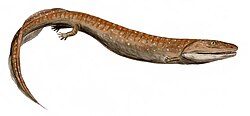| Baphetes Temporal range: Carboniferous | |
|---|---|
| Scientific classification | |
| Domain: | Eukaryota |
| Kingdom: | Animalia |
| Phylum: | Chordata |
| Clade: | Sarcopterygii |
| Clade: | Tetrapodomorpha |
| Family: | † Baphetidae |
| Subfamily: | † Baphetinae Milner et al. 2009 |
| Genus: | † Baphetes Owen 1854 |
| Species | |
| |
Baphetes is an extinct genus of stem-tetrapod from the Pennine Coal Measures Group and Parrot Coal, England, the Joggins Formation of Nova Scotia, and the Kladno Formation of the Czech Republic. It was first named by Richard Owen in 1854. The type species is B. planiceps.
Species B. lintonensis is transferred to genus Loxomma . [1]





